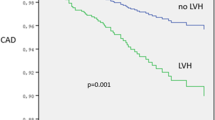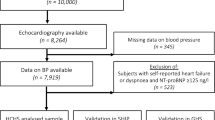Abstract
Left ventricular (LV) mass relates positively and continuously to cardiac mortality and thus its regression is a rational therapeutic aim. Whilst the office blood pressure (BP) relates poorly to LV mass, it was unclear whether the 24-h ambulatory BP or the exercise systolic BP (ExSBP) was the stronger correlate of LV structural indices. We studied 49 hypertensive patients with a mean age of 45 (s.d. 12) years with a mean body mass index of 27.1(3.9) kg/m2. The mean (s.d.) of office BP, ambulatory BP and ExSBP measured at the end of the first three stages of Bruce protocol treadmill exercise I, II and III were 161(20)/99(10), 140(13)/89(10), 190(30), 198(30) and 201(33) mm Hg respectively. The LV indices measured echocardiographically were LV septal thickness (IVSd) (1.1(0.2) cm), LV posterior wall thickness (LVPWd) (1.0(0.1) cm) and LV mass indexed to body surface area (LVMI) (123(30) g/m2). Age and gender (male) had the highest correlations with the LV indices. Of the BP measures, the stage II ExSBP’s correlation with the LV indices was consistently higher than all other ExSBP, office systolic BP and 24-h systolic ambulatory BP. In a stepwise multiple regression analysis on IVSd, after adjusting for age and gender, the stage II ExSBP was independently associated with IVSd (β= 0.018 (s.e. 0.008), P = 0.024). When only BP measures were considered as explanatory variables only stage II ExSBP was a significant predictor (P = 0.0001) of IVSd as was the case with LVPWd (P = 0.006) and LVMI (P = 0.0008). Submaximal exercise BP measured at a workload comparable to physical activity encountered in daily life correlated more closely with the left ventricular wall thickness and mass. The exercise BP should perhaps be normalised in hypertension management to optimise regression of LV hypertrophy.
This is a preview of subscription content, access via your institution
Access options
Subscribe to this journal
Receive 12 digital issues and online access to articles
$119.00 per year
only $9.92 per issue
Buy this article
- Purchase on Springer Link
- Instant access to full article PDF
Prices may be subject to local taxes which are calculated during checkout
Similar content being viewed by others
References
Schillaci G et alContinuous relation between left ventricular mass and cardiovascular risk in essential hypertension Hypertension 2000 35 580–586
MacMahon S et alBlood pressure, stroke, and coronary heart disease. Part 1, Prolonged differences in blood pressure: prospective observational studies corrected for the regression dilution bias Lancet 1990 335 765–774
Verdecchia P et alPrognostic significance of serial changes in left ventricular mass in essential hypertension Circulation 1998 97 48–54
Devereux RB et alLeft ventricular hypertrophy inpatients with hypertension: importance of blood pressure response to regularly recurring stress Circulation 1983 68 470–476
Schillaci G et alIncomplete normalization of left ventricular mass in well-controlled hypertension Am J Hypertens 1998 11 3A
Pierdomenico SD, Bucci A, Cuccurullo F, Mezzetti A White coat responder hypertension Am J Hypertens 1998 11 49A
Staessen JA, O’Brien ET Development of diagnostic thresholds for automated measurement of blood pressures in adults Blood Press Monit 1999 4 127–136
Verdecchia P Prognostic value of ambulatory blood pressure: current evidence and clinical implications Hypertension 2000 35 844–851
Lim PO, MacFadyen RJ, Clarkson PB, MacDonald TM Impaired exercise tolerance in hypertensivepatients Ann Intern Med 1996 124 41–55
Cardillo C et alRelation of stress testing and ambulatory blood pressure to hypertensive cardiac damage Am J Hypertens 1996 9 162–170
Ramsay L et alGuidelines for management of hypertension: report of the third working party of the British Hypertension Society J Hum Hypertens 1999 13 569–592
Sahn DJ, DeMaria A, Kisslo J, Weyman A Recommendations regarding quantitation in M-mode echocardiography: results of a survey of echocardiographic measurements Circulation 1978 58 1072–1083
Devereux RB et alEchocardiographic assessment of left ventricular hypertrophy: comparison to necropsy findings Am J Cardiol 1986 57 450–458
Hammond IW et alThe prevalence and correlates of echocardiographic left ventricular hypertrophy among employedpatients with uncomplicated hypertension J Am Coll Cardiol 1986 7 639–650
Mancia G et alAmbulatory blood pressure is superior to clinic blood pressure in predicting treatment-induced regression of left ventricular hypertrophy. SAMPLE Study Group. Study on Ambulatory Monitoring of Blood Pressure and Lisinopril Evaluation Circulation 1997 95 1464–1470
Cuspidi C et alBlood pressure control in a hypertension hospital clinic J Hypertens 1999 17 835–841
Staessen JA et alPredicting cardiovascular risk using conventional vs ambulatory blood pressure in olderpatients with systolic hypertension. Systolic Hypertension in Europe Trial Investigators JAMA 1999 282 539–546
Levy D et alEchocardiographically detected left ventricular hypertrophy: prevalence and risk factors. The Framingham Heart Study Ann Intern Med 1988 108 7–13
Daniels SD, Meyer RA, Loggie JM Determinants of cardiac involvement in children and adolescents with essential hypertension Circulation 1990 82 1243–1248
Opie LH Mechanism of Cardiac Contraction and relaxation. In: Braunwald E (ed) Heart Disease: a textbook of cardiovascular medicine WB Saunders: Philadelphia 1997 360–393
Devereux RB, Pickering TG Relationship between ambulatory or exercise blood pressure and left ventricular structure: prognostic implications J Hypertens 1990 8 (Suppl 6) S125–S134
Papademetriou V et alExercise blood pressure response and left ventricular hypertrophy Am J Hypertens 1989 2 114–116
Clement DL, De Buyzere M, Duprez D Prognostic value of ambulatory blood pressure monitoring J Hypertens 1994 12 857–864
Gosse P Campello G, Aouizerate E, Dallocchio M. Left-ventricular hypertrophy in hypertension – correlation with exercise and ambulatory blood-pressure J Hypertens 1986 4 645
Grossman E et alLeft ventricular mass in hypertension: correlation with casual, exercise and ambulatory blood pressure J Hum Hypertens 1994 8 741–746
Lund-Johansen P Twenty-year follow-up of hemodynamics in essential hypertension during rest and exercise Hypertension 1991 18 III54–III61
Mundal R et alClustering of coronary risk factors with increasing blood pressure at rest and during exercise J Hypertens 1998 16 19–22
Messerli FH, Schmieder RE, Weir MR Salt A perpetrator of hypertensive target organ disease? Arch Intern Med 1997 157 2449–2452
Schlaich MP et alRelation between the renin-angiotensin-aldosterone system and left ventricular structure and function in young normotensive and mildly hypertensive subjects Am Heart J 1999 138 810–817
Draaijer P et alVascular distensibility and compliance in salt-sensitive and salt-resistant borderline hypertension J Hypertens 1993 11 1199–1207
Lim PO, Donnan PT, MacDonald TM Aldosterone to renin ratio as a determinant of exercise blood pressure response in hypertensivepatients. 18th International meeting of the International Society of Hypertension, 2000, Chicago
Rossi GP et alRemodeling of the left ventricle in primary aldosteronism due to Conn’s adenoma Circulation 1997 95 1471–1478
Ostman-Smith I Cardiac sympathetic nerves as the final common pathway in the induction of adaptive cardiac hypertrophy Clin Sci 1981 61 265–272
Sun Y, Weber KT Angiotensin II and aldosterone receptor binding in rat heart and kidney: response to chronic angiotensin II or aldosterone administration J Lab Clin Med 1993 122 404–411
Kop WJ, Gottdiener JS, Patterson SM, Krantz DS Relationship between left ventricular mass and hemodynamic responses to physical and mental stress J Psychosom Res 2000 48 79–88
Andersson OK et alSurvival in treated hypertension: follow up study after two decades BMJ 1998 317 167–171
Lim PO, Shiels P, MacDonald TM The Dundee Step Test: a novel exercise test suitable for the outpatient management of hypertension J Hypertens 1998 16 1701
Filipovsky J, Ducimeticre P, Safar ME Prognostic significance of exercise blood pressure and heart rate in middle-aged men Hypertension 1992 20 333–339
Mundal R et alExercise blood pressure predicts cardiovascular mortality in middle-aged men Hypertension 1994 24 56–62
Mundal R et alExercise blood pressure predicts mortality from myocardial infarction Hypertension 1996 27 324–329
Lim PO, Donnan PT, MacDonald TM Does the Dundee Step Test predict outcome in treated hypertension? A sub-study protocol for the ASCOT trial J Hum Hypertens 2000 14 75–78
Lim PO, Donnan PT, MacDonald TM How well do Office and Exercise Blood Pressures Predict Sustained Hypertension? A Dundee Step Test Study J Hum Hypertens 2000 14 429–433
Lim PO, Rana BS, Struthers AD, MacDonald TM Exercise systolic blood pressure is an independent predictor of corrected maximum QT interval in hypertension [Abstract] Am J Hypertens 2000 13 213A
Giaconi S et alLeft ventricular mass in borderline hypertension, assessed by echocardiography. Relationships with resting and stress blood pressure J Nucl Med Allied Sci 1989 33 26–31
Nathwani D, Reeves RA, Marquez-Julio A, Leenen FH Left ventricular hypertrophy in mild hypertension: correlation with exercise blood pressure Am Heart J 1985 109 386–387
Knutsen KM et alCorrelations between left ventricular mass and systolic blood pressure at rest and during maximal exercise in moderately hypertensive men J Hum Hypertens 1991 5 149–154
Tanaka H, Bassett DR, Jr, Turner MJ. Exaggerated blood pressure response to maximal exercise in endurance-trained individuals Am J Hypertens 1996 9 1099–1103
Ren JF, Hakki AH, Kotler MN, Iskandrian AS Exercise systolic blood pressure: a powerful determinant of increased left ventricular mass inpatients with hypertension J Am Coll Cardiol 1985 5 1224–1231
Smith DH et alImpact of left ventricular hypertrophy on blood pressure responses to exercise Am J Cardiol 1992 69 225–228
Schmieder RE et alRelation of hemodynamic reaction during stress to left ventricular hypertrophy in essential hypertension Am J Hypertens 1990 3 281–287
Acknowledgements
Catherine MacLeod for helping with the treadmill exercise tests and did all the echocardiographic examinations. Professor Allan D Struthers for his helpful critique of the paper. (Funding: Anonymous Trust of Dundee, Scotland.)
Author information
Authors and Affiliations
Corresponding author
Additional information
This paper has been published in an abstract form following an oral presentation in the 18th Scientific Meeting of the International Society of Hypertension, J Hypertens 2000; 18 (Suppl 4): S9[4C.04].
Rights and permissions
About this article
Cite this article
Lim, P., Donnan, P. & MacDonald, T. Blood pressure determinants of left ventricular wall thickness and mass index in hypertension: comparing office, ambulatory and exercise blood pressures. J Hum Hypertens 15, 627–633 (2001). https://doi.org/10.1038/sj.jhh.1001229
Received:
Revised:
Accepted:
Published:
Issue Date:
DOI: https://doi.org/10.1038/sj.jhh.1001229
Keywords
This article is cited by
-
An exaggerated blood pressure response to exercise is associated with nitric oxide bioavailability and inflammatory markers in normotensive females
Hypertension Research (2016)
-
Exercise blood pressure: clinical relevance and correct measurement
Journal of Human Hypertension (2015)



